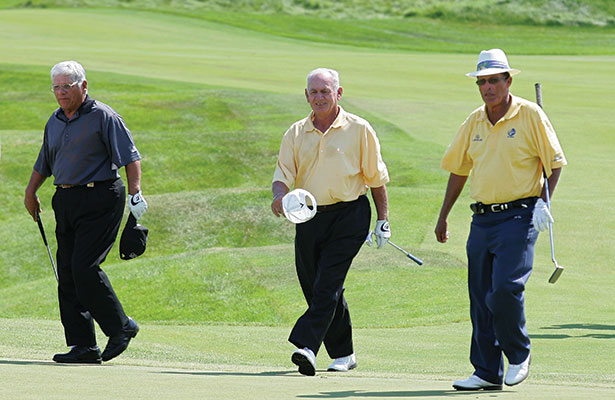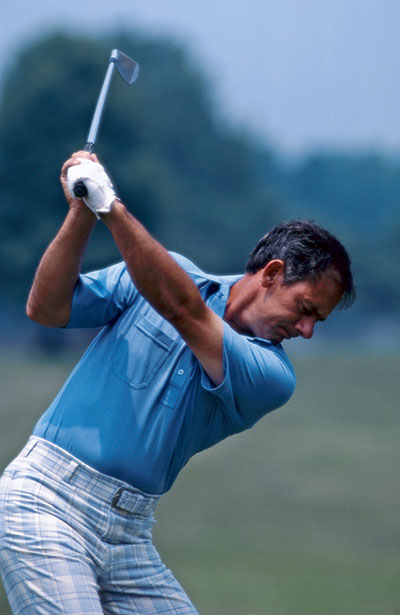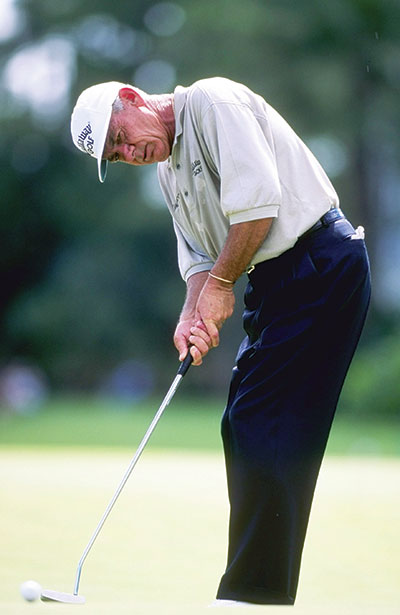Though Hall-of-Famer David Graham’s greatest playing days were more than a generation ago, he had one characteristic that would have made the Aussie a natural in modern golf’s technology-driven world: an obsession with equipment. Graham turned professional at the age of 16, not because he was a prodigy but because it was a job. A big part of that job became learning how to maintain and, ultimately, understand equipment.
As he became a touring professional, Graham continued to tinker with his equipment (by necessity, he points out). He also came to be quite in demand among other players for his skills mending clubs, and later in his career worked with Jack Nicklaus to design irons for MacGregor Golf that were played by many of the best players in the world. Of course, he knew how to use them, too. Graham won 38 times and joined Gary Player, Hale Irwin and Bernhard Langer as the only men to win on six continents. His two Major wins include the 1979 US PGA Championship and a flawless final-round 67 to win the 1981 US Open at Merion. Graham,inducted into the World Golf Hall of Fame this year, sat down with Australian Golf Digest.
Australian Golf Digest: The stories are pretty legendary about your interest in equipment. We’ve heard tales of you changing grips on the range. True?
David Graham: (Lee) Trevino started that rumour, didn’t he?
ADG: What was your motivation to know so much about your equipment?
DG: I learned the trade as an assistant when I did my apprenticeship. In those days, all you ever had were the components and you had to assemble the clubs. When you made wooden woods, all you got was the billet and you had to turn it down and put the inlay in it and put the sole plate on it and drill it and put the tape on and the whipping and all that stuff. I just learned that trade as many people of that era did. I really got into it when I started to play because I never had clubs, and I don’t think I ever did have clubs that I was 100 per cent happy with. It was either the driver was a little hooked or the 3-wood was a little open or 1-iron felt different than the other irons. You’d order grips and there were 12 of them and they were different weights. It’s like being an F1 driver – you want the very best equipment to compete. A lot of players were like that. Trevino was like that. Arnold Palmer was like that. Tom Weiskopf was like that. Johnny Miller was another. I just went in and did it, too. In those days, when you ordered a set of clubs, you’d have to order them in January and you’d order two or three sets. They’d all come assembled and in those days the head weights were a little off so there was still a lot of weight in the hosel and all that kind of stuff. So you’d hit each club in each set and then you’d pick the one that felt best for each club. You’d try to get the ones where the shafts all felt closer together. It wasn’t until Dr Joe Braly came out with frequency matching that let you evaluate shafts based on anything other than feel.
AGD: Your thinking was that if you weren’t precise, you were leaving strokes on the course?
DG: You didn’t have equipment trailers out there, you didn’t have techs out there, you didn’t have instant access to everything the young players do today. We all lived in fear of our driver breaking on Saturday! Or somebody stealing our clubs because security wasn’t that good at the club that week. Most of us used to bring our clubs home every night. To get 13 clubs in the bag where the grips all felt the same was just a never-ending process. You’d put one on and one felt bigger than the other, or one felt too skinny or one had too much cord in it. It just was a never-ending process.
AGD: Did you have any measurement devices?
DG: Not really. The only thing we could do was trust the manufacturer that S meant S and X meant X, and then hopefully out the 150 shafts in that cardboard box, there were a dozen or so that were comparable and you could sort them. So you’d go to the hardware store and buy one of those little gram scales, you’d put one on there and one would weigh 123 grams and the next would weigh 127g. Then the headweight of each head would affect the swing weight. It was really a never-ending pursuit.
Honestly, there were a lot of people like that. I just got more exposure because I was the guy on tour doing it for most of the players. When Weiskopf had a problem, he would get a message out to find me. He would say, “I need David to hit my 6-iron with a hammer twice on the toe because it’s too flat.”
AGD: That’s a tough assignment, trying to satisfy tour players’ equipment needs?
DG: I think the scariest thing I ever did was fix Jack Nicklaus’ George Low putter. That was maybe the hardest thing I’ve ever done. He played the Canadian Open at Glen Abbey and he wasn’t having a good day, and he kicked the putter which he never did really, a very rare display of emotion. He bent the shaft right down near the ferrule. The next thing I hear is Nicklaus has left his putter in my locker and could I fix it before tomorrow’s round. I looked at it and that meant having to take the shaft out, which I did not want to do. I did not want to burn the ferrule, and then putting the shaft back in exactly the same place was near impossible because of the grip. But I got it back straight and I didn’t put it in his locker. I brought it back to him at the hotel and he putted with it for years after that.
He once gave me his driver to refinish a scratch out of it. Refinishing Jack Nicklaus’ driver is a nerve-wracking experience, I promise you that. I got the driver all cleaned up and he says, “Oh that looks beautiful. Can you do the 3-wood, too?”
Now you go out on the US PGA Tour, and guys will walk into the van and say, “I need three drivers and a 7-iron and I’ll be back in an hour.” They’re not saying it to another guy they’re playing with. But we had a lot of fun, we really did. In hindsight, it was a great time, great fun.
AGD: Has current equipment changed the way the game is played at the elite level?
DG: Absolutely. It’s controlled the flight of the golf ball. It’s changed the whole flight of the ball, the trajectory path and the bounce and landing angle of the golf ball is completely different. The 200-metre shot that used to be some kind of 1-iron that didn’t have any spin to it and didn’t have any kind of height on it is now a utility club that has a completely different flight path and a much steeper angle of descent, so the pins are easier to shoot at. The lob wedge has changed the game. Being able to personalise a driver has changed the game. Whoever thought that the pros would be playing with 10 and 12-degree drivers because of the ball? We spent our whole life having less loft and trying to keep the ball down because the ball had so much spin. Now you can get it launched quickly and at such high angles that the possibilities are different.
Having 500 samples of putters at a tournament with interchangeable weights and different sized grips has changed the game.
AGD: Can you imagine your same curiosity with equipment in today’s world on tour?
DG: I think you can very easily get lost in it. But the constant pursuit of perfection is a never-ending process. But if you can keep it under control within reason, then it’s still a journey worth taking. Each shaft is different and performs differently. But certain players are still that way. Phil Mickelson is an absolute club-a-holic. I can’t tell you how many drivers and irons, how many wedges that Callaway make for him. I’ll bet it’s in the thousands. Always trying to find something that works just a little bit better. How many drivers in the last 15 years do you think Tiger Woods has gone through? I mean six months down the road they may be playing the same clubs but it just doesn’t feel the same. So they change. Everything changes so quickly. It’s not a bad thing. If you’re not paying for it, it’s a really good thing.
But I think Arnold Palmer spent his entire career looking to find better clubs than he had. I think Gary Player spent most of his time trying to find better clubs. They knew what they wanted and if that club didn’t produce the type of shot they wanted, it was the club’s fault. I know Palmer spent hours and hours gripping his clubs. Never could get all 13 of them to feel right. Dave Hill was a constant tinkerer and he had tremendous feel. He could tell a shaft that he liked maybe quicker than anybody.
I guess I just got a reputation for it and my reputation increased even more when I went to work for Nicklaus. I got involved with MacGregor because he was looking for a second set and could never get the second set that he was happy with. Even the first set he wasn’t ever completely happy with the type of divots the clubs were taking. In those days they had negative bounce with sharp, digging irons. Guys like Nicklaus and Weiskopf were what we called pickers of the golf ball; they didn’t want to take divots because the clubs really had no bounce. Jack wanted some irons with more bounce in them. So he asked me to get involved in it and he got very involved in it, and in our day, we collaborated and built the best irons in the game back in the late 70s early 80s (the MacGregor VIP). They were clubs that everybody wanted.

AGD: How was it different then?
DG: Well, the industry really wasn’t ready for radical design. They’d really been stuck on a treadmill for 40-50 years with Wilson and MacGregor and Hogan – they were all very similar clubs. Nothing super innovative. Then Ping came along and people would say they couldn’t play golf with those clubs because they were too ugly. But that was more because they weren’t traditional. Then Callaway came along with non-traditional looking clubs. Little did anybody who was on that treadmill know that technology was going to take over the traditional design. I’m going to donate my clubs to the Hall of Fame and I actually looked at them last night and I can’t even believe I played with them. The 1-iron I have to put my bifocals on to see the head. And yet we were all using them, so in that regard I guess none of us had an equipment advantage.
The industry was not ready for CAD [computer-assisted design] and aerodynamic concepts, but then it finally accepted tradition was no longer the best way. CAD computers could design a golf club far better and more consistently through molds than hand grinding and carbon steel.
AGD: Are today’s designs the mixing of the old aesthetic with the new technology?
DG: I don’t think we’ve even seen that to its end yet. There’s probably some young brilliant engineer or aerodynamics expert that’s going to design something even better than what we have today. We just haven’t seen it yet, but it’s inevitable. As Ping and Callaway replace the traditional club, what we now know as cutting edge club technology, they will become obsoleted too. It’s inevitable that somebody will come up with something that’s a little better that will take a little while to accept and get used to, but history proves that it’s going to happen.





